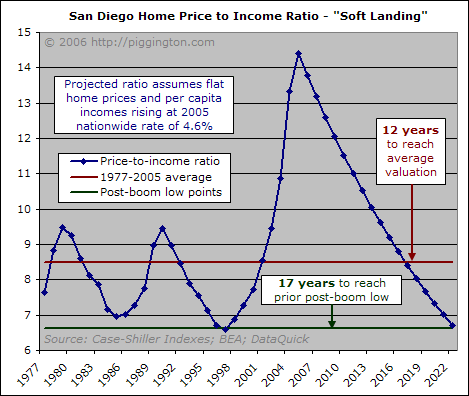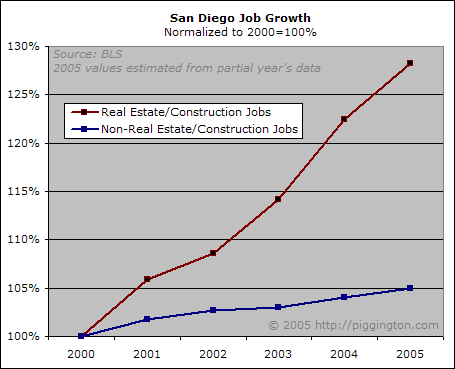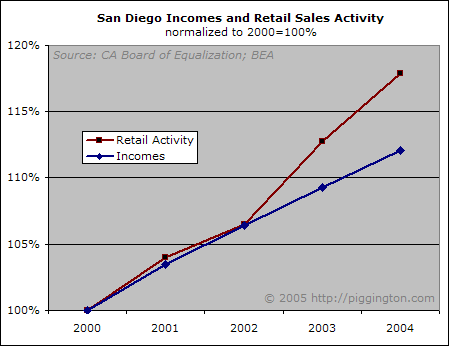The probability of a serious housing downturn is much higher—and that of the oft-heralded “soft landing” much lower—than most people acknowledge.
An Atypical Housing Market
Home prices are notoriously “sticky” on the way down. As demand decreases and sellers find they can’t get the prices they want, many take their homes off the market and stay put. This reduction in supply helps to offset the reduced demand, and prices pretty much stay flat until wages rise or economic conditions improve enough that demand starts to rise again. Thus, a sustained rise in home prices is typically followed by a period of flat or mildly declining prices until the cycle can begin again.
The Southern California real estate market, however, is anything but typical, and there is no good reason to think that the ride down will be any more typical than the ride up. As a matter of fact, there are several factors that pose great risks to the standard-issue “soft landing” scenario:
-
- Southern California prices are so far out of line with incomes, and income growth so slow, that it would take a very long time for incomes to catch up in the usual manner.
- Southern California’s poor affordability renders it unusally susceptible to rising interest rates and tightening lending standards.
- A significant portion of Southern California homebuyers are dependent on continued home price growth to maintain their fiscal solvency.
- The local Southern California economies are vulnerable to a slowdown in either housing activity or home price appreciation.
- Southern California homes are priced based on unrealistically high expectations of future gains.
Nobody can predict exactly how a market is going to play itself out; the best one can do is to assess the probabilities of potential outcomes. To that end, my purpose as I detail each of the above points is to explain why the probability of a serious housing downturn is far higher—and that of a soft landing far lower—than most market participants acknowledge. As with my article on the Evidence of a California Housing Bubble, I will use San Diego as an example case—but the risks I am describing apply to all of Southern California as well.
Incomes Have a Lot of Catching Up To Do
As discussed above, if home prices overshoot there usually follows a period where prices stay somewhat flat or decrease mildly until wages “catch up” and the ratio of home prices to incomes returns to normalcy. For instance, San Diego’s last housing downturn saw nominal home prices decline about 10% from peak to trough. 10% may have felt like a lot to homeowners at the time, but such a fall was actually quite mild compared to that experienced by the ratio of home prices to incomes, which fell by a full 26%.
The following graph of San Diego’s per capita income divided by the median-priced home indicates why the price-flattening scenario is not likely going to happen this time around:

If prices were to suddenly flatten out right now, assuming a continuation of last year’s wage growth, it would take 12 years for home prices to get down to the historical average of 8.5 times per capita income. It would take 16 or 17 years for home valuations to get down to the low points that have followed each prior boom.
That’s a long time to go without the local economy experiencing any hardship. Keep those figures in mind the next time someone tells you that home prices “will just flatten out for a while until incomes catch up.”
It should be noted that if incomes were to start growing significantly faster than they are now it would not take so long for home prices to get back in line. However, such wage inflation would in all likelihood be accompanied by rising mortgage interest rates. Which brings me to the next area of concern.
Credit Risk
The California Association of Realtors (CAR) Affordability Index places San Diego affordability at 9% at the time of this writing. This means that only the top 9% of income earners can “afford” to purchase the median-priced home using a 20% down payment on a fixed-rate mortgage.
It is obviously not the case that fully half of all homes are being bought by the most highly-paid 9% of San Diegans. Instead, what’s going on is that people are getting around the low affordability by making very small down payments and getting “creative” loans whose monthly payments start quite low but increase over time (interest-only, negative amortization, adjustable-rate, or “option ARM” mortgages). This kind of borrowing is quite prevalent—of all San Diego mortgages issued in 2004, 80% were adjustable-rate, 47% were interest-only, and 27% involved no down payment. Similar statistics apply to all of Southern California.
While this “buy now, pay later” strategy has worked well thus far, it has rendered the Southern California housing market unusually vulnerable to rising interest rates or tighter lending standards. If rates were to rise or lending standards tighten (e.g. higher required down payments, lower acceptable payment to income ratios, or fewer “stated income” loans), large swaths of potential buyers would effectively be priced out of the market at current home valuations.
Moreover, if rates are significantly higher when all those ARMs start to adjust, some of the more overleveraged ARM-holders might find themselves unable to afford the higher payments and be forced to sell their homes. The resulting increase in “motivated sellers,” combined with the above-described inability for homes to be purchased at current prices, would almost guarantee a significant home price decline.
Dependency on Rising Prices
Certain homeowners are vulnerable not just to rising rates but to flattening home prices, as well. The nature of many mortgages being taken out in San Diego all but ensures that, even if interest rates stay low, monthly payments on those mortgages will rise significantly in the future. Holders of interest-only loans, which as I mentioned made up almost half of all San Diego mortgages in 2004, will see their payments increase once the principal payoff period begins. And negative amortization borrowers’ payments will increase even more, as their principals actually increase for the first few years of the loan. If holders of these loans do not have a home equity cushion to fall back on, a lot of them will find that their payments eventually increase more than they can afford.
Many buyers of rental property are even more overtly dependent on rising prices. The disparity between sale prices and rent prices is bigger in San Diego than anywhere else in the country, and the rest of Southern California is not much better. Landlords are willingly taking on negative cash flows with the expectation that future equity gains will more than cover the loss.
A lot of Southern California property owners, be they investors or not, are banking on equity gains. If those equity gains fail to materialize and prices simply remain flat, many of these overleveraged homeowners will be in trouble. An increase in foreclosures and must-sell inventory could very well be the result.
Housing and the Economy
The entire Southern California economy, as a matter of fact, has grown quite dependent on the robust housing market. As the following graph makes clear, growth in the construction and real estate industries has significantly outstripped San Diego’s overall level of job growth:

According to the San Diego Union-Tribune, 50% of new San Diego jobs over the past several years have been related to the housing market. A slowdown in home sales could cause job losses in the housing sector, increasing unemployment or precipitating further out-migration from San Diego.
Southern California’s economy has also benefitted from the housing boom, albeit in a less direct manner, via the “wealth effect.” As Californians have watched their net worth skyrocket along with home prices, they have spent more money due to their perceived fiscal health and in many cases have pulled out home equity to directly finance their spending. The following graph compares the growth in local incomes with that in sales tax revenues, which is a pretty good proxy for retail sales activity (2005 data is not yet available):

Between 2002 and 2004, retail activity grew twice as fast as incomes. While it’s difficult to nail down the causes of this disparity with any precision, there is little doubt that the home equity wealth effect played a major role. If California home prices were to flatten for any length of time, the stimulus provided by equity gains would eventually be removed and economic activity would have to fall back in line with incomes. Southern California’s economic dependence on both continued brisk housing activity and ever-increasing home prices poses a major risk to the soft-landing scenario.
Speculative Premium
Considering mortgage interest, property taxes, insurance, and maintenance, it typically costs well over twice as much per month to purchase a given home than it does to rent. (I am talking about actual money spent—principle payments are not included in this calculation—and I have taken the mortgage interest tax deduction into account). While home ownership certainly has its advantages, people have never before been willing to pay so much more to buy than to rent. Why are they doing so now?
The answer is that the expectation of future equity gains has become priced in to the housing market. When people feel that an investment is sure to go up in price, they are willing to pay more for that investment—especially if they fear being eventually priced out of the chance to buy it. The widespread acceptance of the idea that real estate provides enormous, low-risk gains has caused a “speculative premium” to be added to the price of homes in San Diego.
According to The Economist magazine, a 2004 poll of Los Angeles homebuyers found that they expected their home prices to increase a stunning 22% per year for the next decade. This is obviously quite impossible: assuming current interest rates and income growth rates, Los Angeles homebuyers one decade hence would find that the monthly payment on a median-priced home was over 3 times the median monthly income! Whether it’s realistic or not, however, Los Angeles homebuyers actually are expecting gains of this magnitude, and they are paying whatever they have to in order to “get on the ride.”
If home prices were to flatten out, this artificial source of demand would disappear, as would the mistaken idea that no price is too high for real estate. When people once again started to see a home as a place to live instead of a lottery ticket, they might start to ask themselves why they were paying so much when they could rent for so much less. The speculative premium, in other words, could be removed.
Miscellaneous Objections
The factors discussed above should give a good idea why it is possible—and likely—that home prices will experience a major downturn, and why the odds are stacked against a soft landing. Having said my piece about the risks, let me address some of the common objections to the idea that home prices could decline significantly:
-
- It would take a recession to cause a housing downturn The fact that Southern California’s last housing bust coincided with a recession, as housing busts often do, seems to have given this idea special tenacity. However, several of the above-outlined risks to the market, including interest rate increases, credit tightening, and increased foreclosures, could take place absent a recession or possibly even cause a recession. Additionally, people making this argument rarely acknowledge that the region is especially prone to recession due to its dependence on continued gains in the housing market.
- There isn’t that much speculation going on. This is simply not true. People who are getting interest-only or negative amortization mortgages because that’s the only way they can afford a house are manifestly speculating that their equity will rise faster than their payments. The fact that they intend to live in the house doesn’t mean that they aren’t speculating. Furthermore, while single family homes are still mostly owner-occupied, condos are seeing a lot of speculative activity: according to the San Diego Union-Tribune, about 40% of condo purchases are made by speculators.
- Southern California has a limited supply of land. It sure does, but this in no way renders it immune to a housing downturn. As one of many examples, home prices in Japan, whose land supply is quite a bit more limited than ours, have fallen almost 40% since the early 1990s. Los Angeles prices fell 20% in the early 90s and San Diego fell 10% (both after booms that pale in comparison to the current price runup). A limited supply of land does not justify a rapid rise in home prices, nor does it preclude a home price decline.
- Everyone wants to live here. I examined this premise in detail in Evidence of a California Housing Bubble but suffice it to say that it is the ability of people to sustainably afford homes at these prices, and not Southern California’s desirability, that is in question.
- People need somewhere to live. This argument seems to be implying that because people need somewhere to live, and you can live in homes, homes therefore cannot decline in price. It’s certainly true that housing markets are not as liquid and volatile and crash prone as the stock market. But the idea that homes can’t decline in value because people live in them is neither borne out by the evidence (homes have declined in price many, many times in the past) nor by logic (didn’t people need somewhere to live 5 years ago?).
- People have been saying we’re in a bubble for a while, and it still hasn’t popped. We have been in an obvious bubble for quite some time now—how does the fact that someone recognized it as such make the idea any less valid? A bubble occurs when excessive optimism pushes an asset price higher than its fundamentals would dictate. That Southern California homes were already overpriced two years ago and are now more expensive doesn’t mean that they weren’t overpriced in the first place. It means that they are even more overpriced now.
Playing the Odds
Again, neither I nor anyone else can predict exactly how the market will behave in the future. One can, however, predict probabilities. And given all the risks facing Southern California housing, it is clear that a serious price decline is a much greater probability than most people expect.

[…] writing this article, I did attempt to quantify the wealth effect via this graph from my article on risks of a hard landing. ** Hard to believe, but true… the inflation data came from the BLS and the income data from […]
[…] This article has primarily focused on how prices got where they are. For a discussion of where they might go from here, please read the article entitled Risks of a Serious Home Price Decline. […]